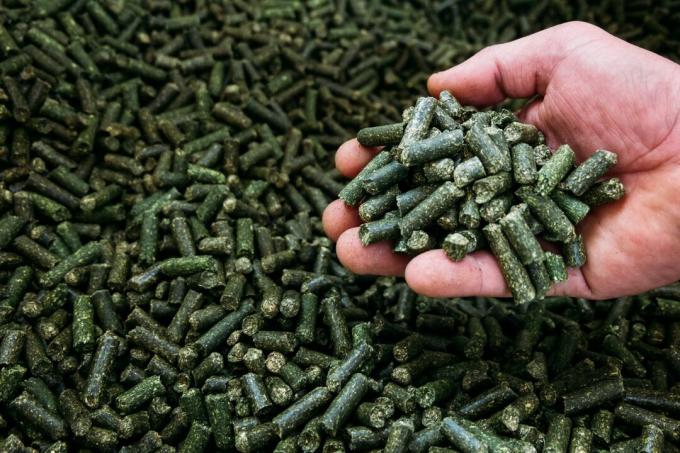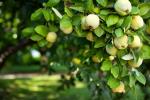Alfalfa is grown as green manure and as a fodder crop, especially for horses. Because of its high protein content and the impressive yield of dry matter, it is also called the "queen of forage plants".

However, lucerne (Medicago spec.) plays an important role - it is also an important food source for wild bees with its good supply of nectar and persistent flowering. In this article you will learn everything about the cultivation and possible uses of alfalfa.
Contents
-
Alfalfa: origin and properties
- When does alfalfa bloom?
- Alfalfa as green manure
- Growing alfalfa in the garden
- The right care
- Harvesting and using alfalfa
Alfalfa: origin and properties
the kind Medicago sativa is also known by the names alfalfa, seeded alfalfa and evergreen clover. The synonym snail clover comes from the rolled-up seeds that resemble a snail shell. In most cases, however, the alfalfa cultivated in this country is now the so-called bastard alfalfa or the bastard snail clover (
Medicago x various), which is a cross between seed alfalfa and sickle lucerne (Medicago falcata) has arisen. In Germany, a distinction is made between two perennial types of lucerne: one type is closer to sickle lucerne in its properties, the other type is more similar to seed lucerne. The species are assigned to the legume family (Fabaceae) and belong to the legumes (Faboideae), i.e. to the legumes. Alfalfa is the oldest cultivated plant that was cultivated exclusively for fodder - as early as around 500 BC. Chr. was used for it. It comes from south-west Asia and its cultivation in Germany must have been introduced in the 18th century. century have taken place. Apart from field cultivation, alfalfa is often found growing wild on roadsides and field edges, in bushes, dry meadows and ruderally influenced semi-arid grasslands.
Both cultivated lucerne species are perennial, herbaceous plants that have green leaves all year round. The hybrid lucerne reaches a height of 30 to 80 cm, while the seed lucerne can grow up to about 1 m high. Both species form a taproot as the primary root, and the root depth of lucerne can be up to 4.5 m. The outlasting buds are either a few centimeters above the earth's surface or at the same height - they overwinter as a chamaephyte or hemicryptophyte. The erect, branched stalks of the alfalfa plants are alternately arranged in threefold pinnate leaves. Their shape is elongate-lanceolate to elliptical and the leaf edges are usually serrate at the top. The stalk of Medicago sativa is also square and more or less hairy. The hermaphroditic, mirror-symmetrical flowers sit in racemose inflorescences on long stalks. They can be bluish to purple, purple, greenish-yellow, or white in color. Bumblebees and wild bees in particular enjoy the flowers of the alfalfa, but also butterflies. Alfalfa has a good supply of nectar, but it only contains small amounts of pollen. The brown legumes of the seed lucerne are hairy and spirally coiled about two to three times. They contain about 10 to 20 seeds. The smooth husk of the hybrid lucerne is twisted 0.5 to 2.5 times and contains 3 to 8 seeds. The long-lived seeds are kidney-shaped and yellowish-orange to light brown in color. They are thrown out of the slightly opened pods when the fruit is ripe and spread by humans, the wind or animals.
When does alfalfa bloom?
The flowering period of the bastard alfalfa extends from June to August. In the case of seed lucerne, on the other hand, the flowering lasts until September.

Alfalfa as green manure
As a legume, lucerne also has the ability to bind nitrogen from the air with the help of nodule bacteria (rhizobia) in its roots. So if the alfalfa is then worked into the soil, the nitrogen will become available for the following crop as it decomposes. Especially for heavy feeder How potatoes (Solanum tuberosum), cabbage (Brassica), Corn (Zea mays) or pumpkin (Cucurbita) the alfalfa is wonderfully suitable as a pre-culture. Apart from that, thanks to its extensive root system, alfalfa helps to improve the soil structure by loosening it in depth thanks to the taproot. It also acts as a protection against erosion. It also automatically serves as pasture for bees and other insects, making alfalfa a good choice green manure might. Not only insects, but also wild animals such as deer or hares enjoy the food available on arable land.

Growing alfalfa in the garden
Alfalfa does very well in a sunny, warm location with calcareous, well-drained, nutrient-rich soil. Deep clay or loess soils, for example, would be suitable soil types. Heavily compacted soils with waterlogging or an acidic pH value should be avoided. The optimal pH value of the subsoil for alfalfa cultivation is around 6.5 to 7.5. Because of its root system, alfalfa copes better with drought than with moisture, so the soil should be dry to moderately fresh. However, since the cultivated plant has a high water requirement, the storage capacity of the substrate also plays a role. Alfalfa can be sown from April to mid-August. If it is sown in spring, it can develop vigorously until winter and survives it without any problems. The best time is mid-April, when the germination temperature of at least 5 °C has been reached in the soil. To prepare the soil, all weeds should be removed and the soil should be deeply loosened. The seeds can now be placed about 1 to 1.5 cm deep in the finely crumbly seedbed and finally pressed flat. As far as the sowing rate of lucerne is concerned, about 25 to 30 g are needed per 10 m². On larger areas, for example, the lucerne seed can be spread and easily incorporated with a rake. The earth can be pressed down again with the back of the rake. The lucerne should be kept evenly moist at least until germination and ideally also in the young plant stage. The first seedlings should appear after about 7 to 14 days.
Tip: Did you know that alfalfa can also be cultivated on the windowsill or directly in the kitchen? In the form of Alfalfa sprouts even in winter, the plant can refine dishes in a variety of ways and represent a valuable addition.

The right care
After successful germination and establishment, watering the alfalfa can be clearly neglected. As soon as a sufficient root system has developed, the plant can cope well with dry periods. The legume family has a high need for potassium and calcium. Therefore, it makes sense to use a potassium-rich fertilizer with calcium content. A long-term fertilizer granulate is best suited here, which is applied in spring and releases its nutrients over several months. Nitrogen should either not be contained in the fertilizer at all or only in small amounts, since the lucerne takes care of itself.
Liming of the soil may be necessary in some cases to maintain or achieve the optimal pH value and for the supply of magnesium or calcium. To find out whether liming would be helpful for your floor, you should first soil pH and the soil type determine. We explain in detail how this works in our corresponding articles. Our fine-grained lime, for example, provides a high-quality lime Plantura Organic Lawn & Garden Lime dar: By balancing the pH value, our odorless garden lime ensures more active soil life, especially on acidic soils, and thus improved soil fertility. You don't have to worry about free-roaming pets or garden animals when applying, because the lawn and garden lime is harmless to them.

Organic Lawn & Garden Lime 15 kg
- High-quality, fine-grained lawn & garden lime for improved soil fertility
- Against weeds and moss: Brings acidic soil back into balance
- Suitable for spreaders and easy to spread - harmless to pets and garden animals
In agriculture, lucerne is usually grown for two to three years and cut three to four times a year for use as a fodder plant. The first cut to a height of about 10 cm should have taken place after the end of the flowering period at the latest. If the lucerne is used as green manure, it is also mowed off depending on the sowing date and finally incorporated. If the plant has already been sown early in the year, it should be cut before the seed ripens at the latest, so that it does not sow again. In autumn, the alfalfa can be incorporated into the soil. If the snail clover was only applied later in the year, it can be left over the winter and only mowed the following year. Lucerne is hardy to about -20 °C and can therefore be cultivated for several years without any problems. Only the annual alfalfa (Medicago scutellata) is an exception to which this does not apply. The frost-hardy plants should not be sown after mid-August, otherwise they will not be able to grow sufficiently until winter and are therefore more sensitive to low temperatures. Regarding the crop rotation there should be a 4 to 6 year break between the repeated cultivation of alfalfa or other legumes.

Harvesting and using alfalfa
As you have already learned from the care measures for lucerne, it is cut and dug under several times or once, depending on the intended use. Since working the lucerne into the soil can not be easy, small machines such as a tiller or a mulching mower are very helpful. After shredding or pruning the alfalfa, the plant matter can be used as a nutrient mulch. In agriculture, alfalfa is often used for ensiling or for pellet, briquette and Bale production used - less often the plant is used dried than hay, as it requires less suitable is. Because of the high content of protein and minerals as well as the excellent yield performance, alfalfa is an important forage plant. Lucerne is mainly used as feed for horses, but the plant is also suitable for other animals such as cattle, chickens and rabbits.
For us, alfalfa is not only edible in the form of sprouts, because its flowers and young leaves are also edible. It is possible to harvest seeds from alfalfa yourself. You have to choose the right time for this: the pods should be brown and as dry as possible. However, if you wait too long, you have to reckon with the fact that they have already opened up and spread the seeds themselves.

Alfalfa is often used in mixtures with clover species such as red clover (Trifolium pratense) deployed. Also the pretty one Crimson Clover (Trifolium incarnatum) is used as a green manure plant and occasionally for fodder production.
Register now for our Plantura garden post, secure a 10% welcome discount for our online shop and Weekly great tips, seasonal trends and inspiration for all things gardening from our expert receive.



